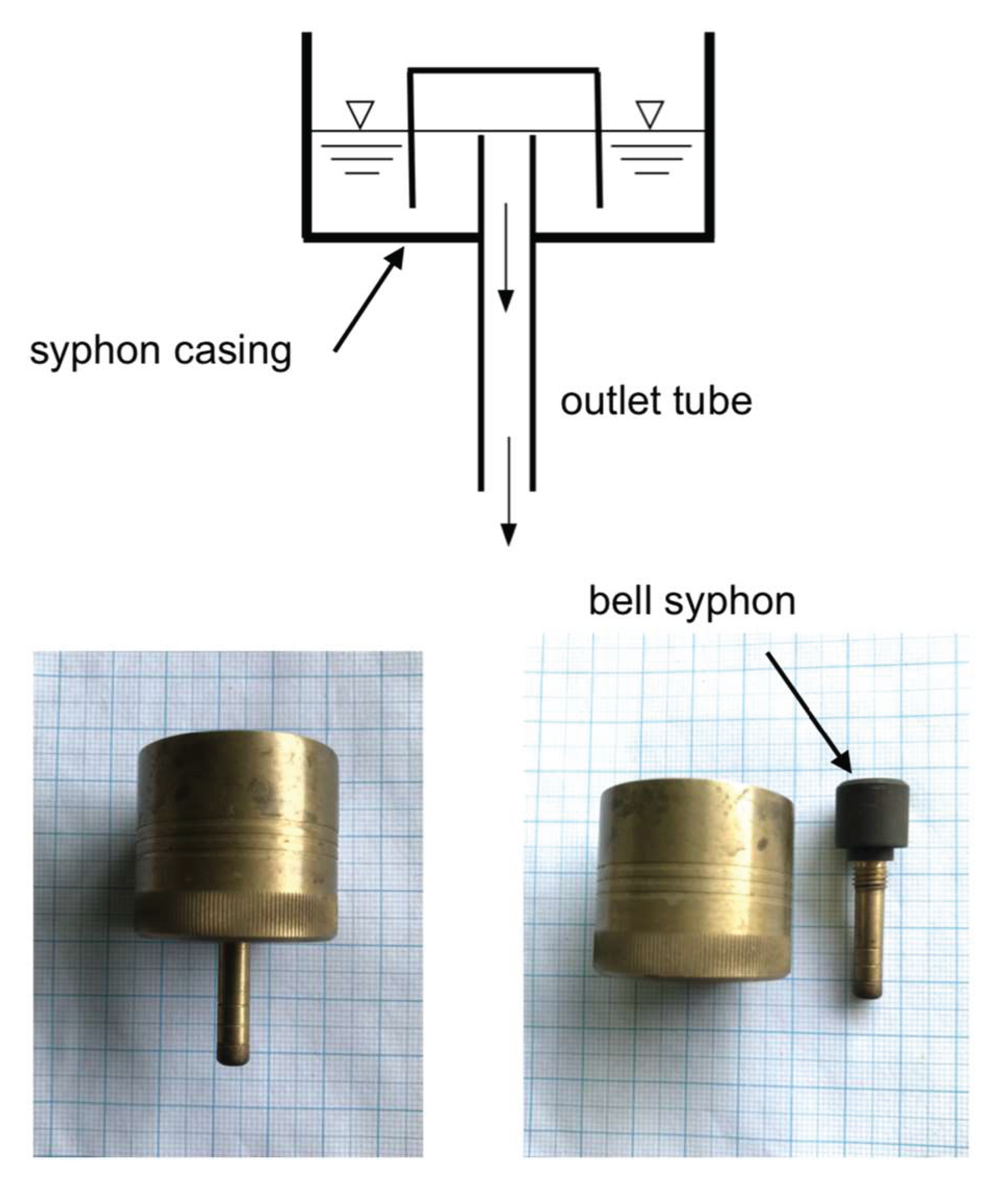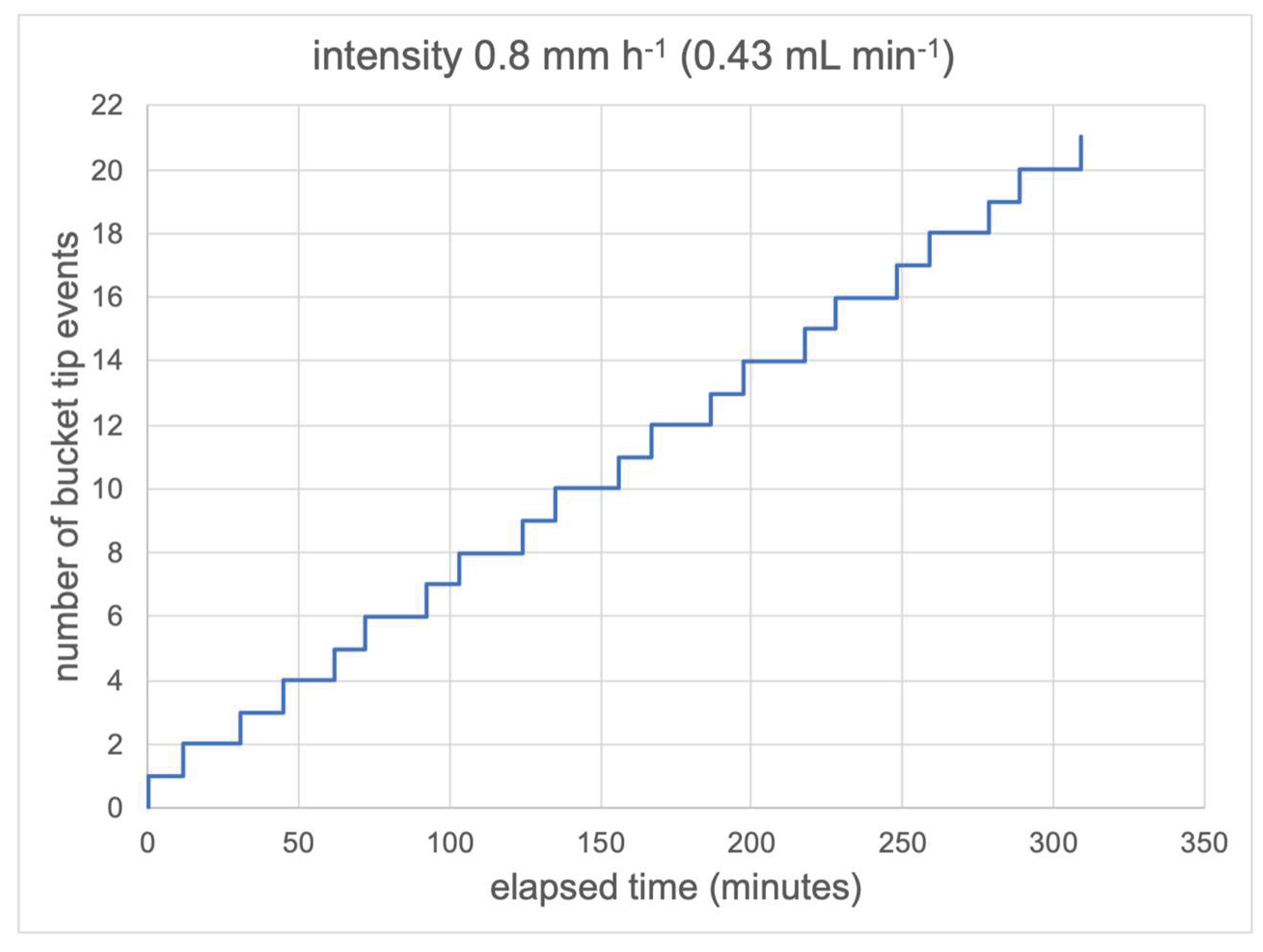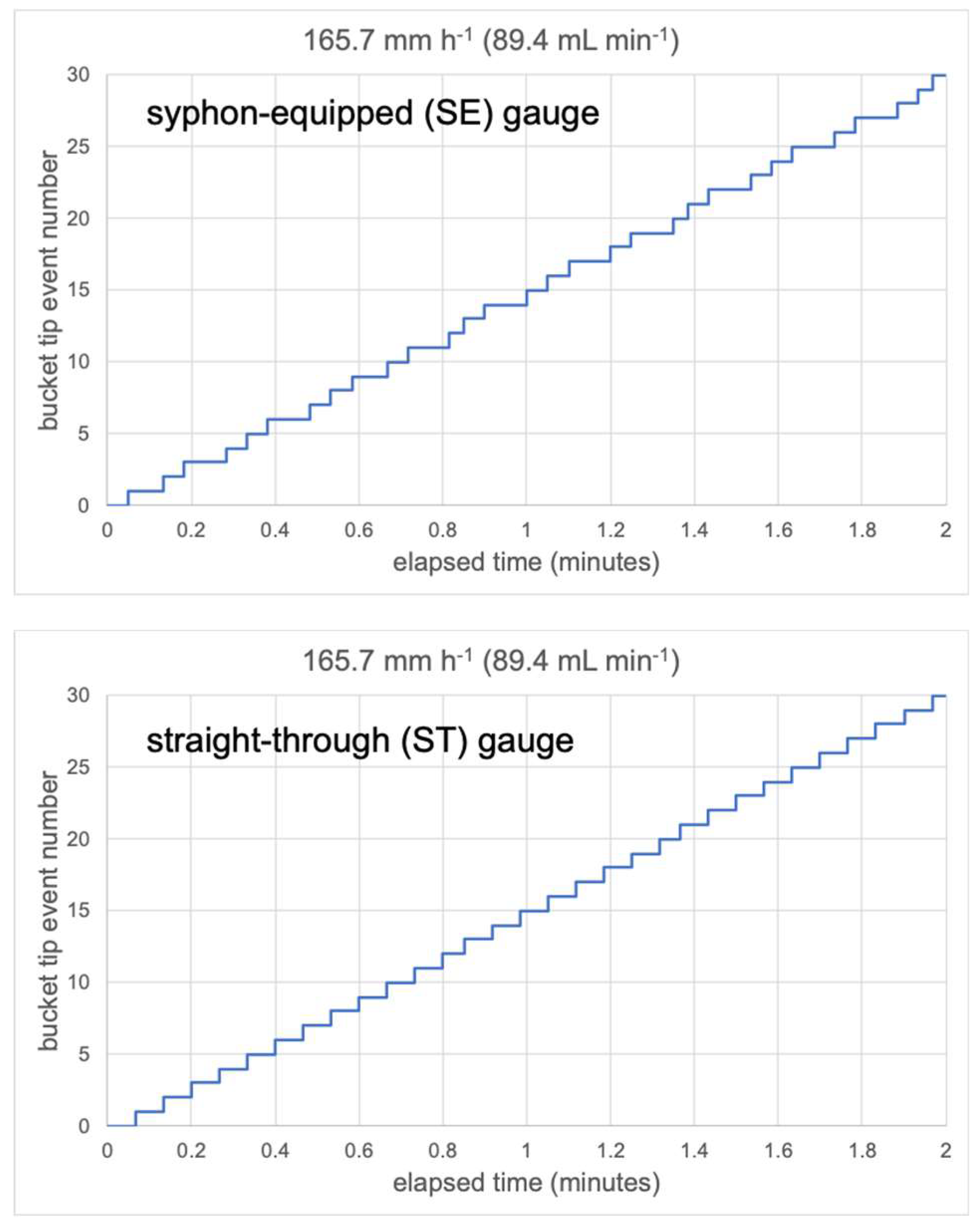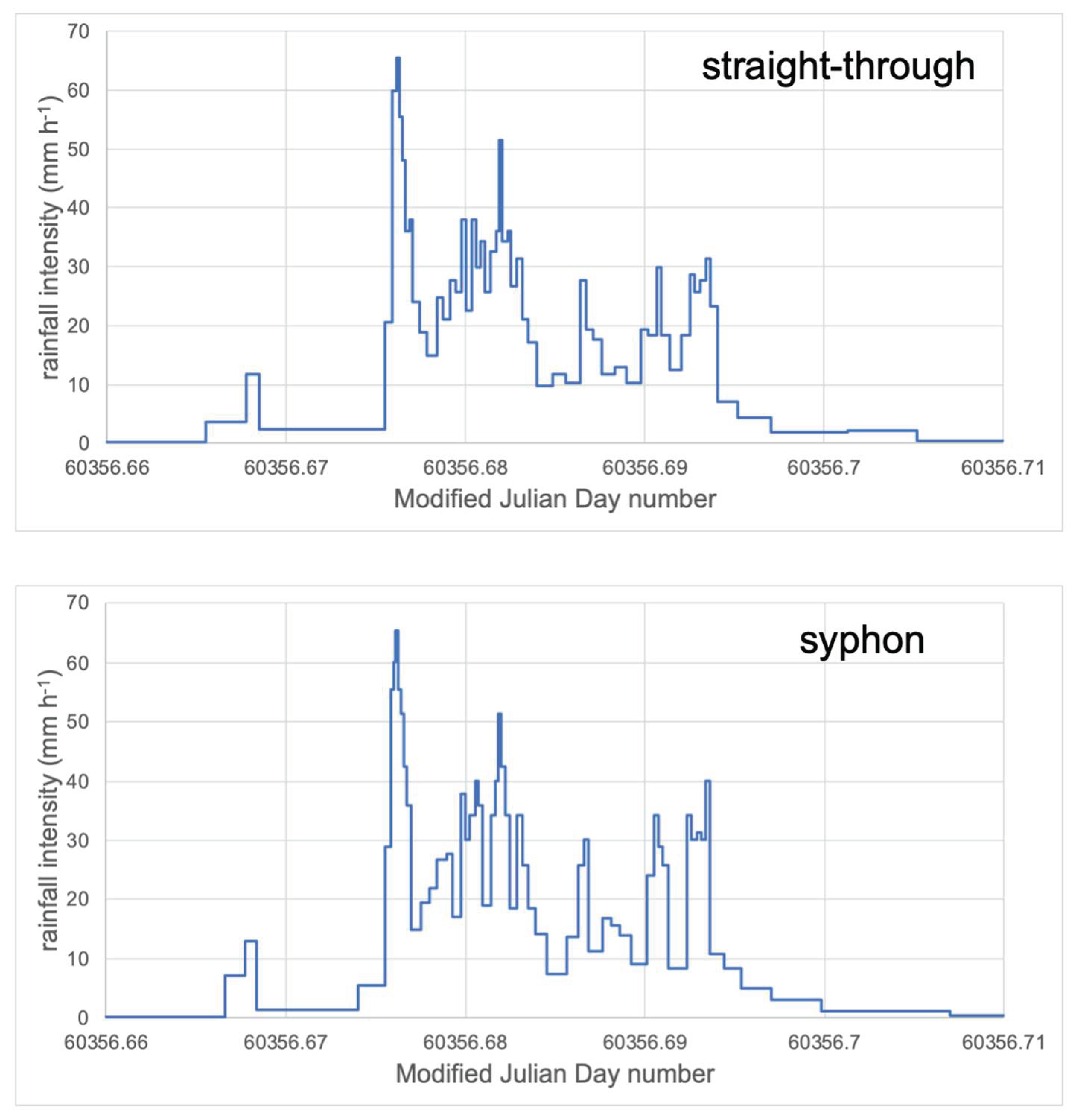1. Introduction
Tipping-bucket rain gauges (TBRGs) are widely-used globally, both for routine climatological data collection, and for the provision of ground truth against which various other methods of rainfall recording, such as remotely-sensed satellite data, can be validated. It is well-known that TBRGs have several inherent limitations (Segovia-Cardozo et al. 2021, 2023 [
1,
2]), including the time delay arising from bucket-filling, especially in rain of low intensity, which may result in the beginning of rain being recorded later than the true commencement time. TBRGs may also fail to record the last phases of a rainfall event, if a bucket remains only partially filled. Even when seemingly high-resolution, one-minute rainfall totals are recorded, the smallest amount of rain that can be recorded in one minute is typically 0.2 mm (the sensitivity of many TBRGs). This means that rainfall rates can only be recorded in steps of 12 mm h
-1 (60 min x 0.2 mm), which is rather poor resolution. Two tips in one minute would then suggest a rainfall rate of 24 mm h
-1, three tips in one minute 36 mm h
-1, and so on. Clearly, even one-minute TBRG data, often portrayed as being 'high-resolution' data, are incapable of approximating moment-to-moment intensity fluctuations. This situation has led to the analysis of the sequence of individual bucket tip events and the inter-tip time (ITT) between them, which can readily be logged to 1 s resolution using inexpensive event data loggers, such the Hobo event logger (
https://www.onsetcomp.com/products/data-loggers/ua-003-64, accessed 5 March 2024), which record, for each tip, the Gregorian calendar date and time. Such data are regarded as providing the highest temporal resolution achievable with a TBRG (Cauteruccio et al. 2021 [
3]). The potential for improved ability to capture intensity fluctuations can be seen from considering the typical values of ITT in rain of varying intensity. For a TBRG with 0.2 mm sensitivity, the ITT at 50 mm h
-1 is 14.4 s, and this declines to 4.8 s at 150 mm h
-1. Thus, in rain whose intensity fluctuates between 50 mm h
-1 and 150 mm h
-1, there may be approximately 4 - 12 tips of varying duration in each minute. The information contained in the durations of the associated ITTs is sacrificed if data are aggregated even to 1 min accumulation times and logged at that rate. Data aggregated to 5 min level (e.g. Saidi et al. 2014, [
4]) during which time there could be 21 – 63 tip events, sacrifice correspondingly more resolution. Hourly data reveal little about actual rainfall intensities (Costello & Williams 1991, [
5]), since they cannot reveal intensity fluctuations nor sub-hourly intermittency. The analysis of intensity from the unaggregated sequence of ITTs logged during rainfall can thus potentially unlock a much higher level of temporal resolution in intensity data. A study of Arkansas rainfall (Costello & Williams 1991, [
5]) provides a useful example. Logging individual tip times for a 0.5 mm sensitivity gauge, they reported a maximum intensity of 500 mm h
-1 (indicated by an ITT of < 4 s) but a maximum 1-minute intensity of only 296 mm h
-1.
To improve the undercatch exhibited by TBRGs at high rainfall intensities (Humphrey et al. 1997 [
6], Santana et al. 2015 [
7], Sypka 2019 [
8]), many are equipped with a small bell syphon. The purpose of the syphon is to deliver the water in rapid bursts that regulate some of the fluctuations in inflow rates to the TBRG mechanism caused by intensity variation. Nevertheless, some proportion of the water always remains unmeasured and contributes to undercatch. Syphon-equipped gauges (hereafter SE gauges) tend to record more rainfall at higher intensities than do 'straight-through' gauges (those without a syphon; hereafter ST gauges). This effect was quantified by Kimball et al. (2010 [
9]) who analysed 1-minute data from several Alabama locations, and showed that there was little difference between the two types of gauge at low intensities. However, at a 1-min intensity of 240 mm h
-1, the SE gauge recorded a mean intensity that was ≥ 48 mm h
-1 higher than the ST gauge, for which more water went unmeasured owing to continued inflow to a bucket during tipping.
SE TBRGs introduce a further complication in the analysis of unaggregated ITTs. This is because, across a fairly wide range of rainfall intensities, syphons accumulate water draining from the gauge collecting funnel, without releasing any to the tipping-bucket mechanism. Once filled to a critical level, the syphon emptying cycle begins, discharging its stored contents rapidly into the tipping buckets. Suppose that the syphon chamber discharges a volume of 4 mL when it empties. Then, for a TBRG having a collecting funnel 203 mm in diameter exposed to rain at 1 mm h-1, the syphon will take ~ 7.4 min to fill before it passes anything to the tipping-bucket mechanism. The TBRG can record nothing until this time has elapsed. The bucket volume of this TBRG needed to trigger a tip event would nominally be 6.47 mL. Thus, the first syphon emptying would only be sufficient to fill a bucket to 62% of its capacity, and no tip event would result. A further 7.4 min for the syphon to fill a second time would be needed to trigger another syphon emptying cycle and fill the bucket. This is a total delay of almost 15 minutes before any rain could be recorded by the TBRG, even though with no syphon, the bucket would have been filled in 12 minutes. Thus, the syphon has lengthened the ITT by 25%. A further problem then emerges. Having filled the first bucket, and triggered a tip event, the syphon emptying would then deliver the excess water, i.e., 1.53 mL, into the second bucket. A third syphon emptying would add 4 mL to the existing 1.53 mL, filling the second bucket to 5.53 mL, or ~ 85.5% capacity. Again, no tip would occur, and a fourth syphon cycle, with a total bucket filling time again totalling almost 15 minutes, would be needed to trigger a tip. This would fill the bucket to tipping with an additional 0.94 mL, and the excess 3.06 mL would drain to the first bucket. The next syphon cycle would then be sufficient to cause an immediate tip, since (4 mL + 3.06 mL) = 7.06 mL, which exceeds the nominal bucket volume. Therefore, some syphon emptyings fail to trigger a bucket tip, while other emptyings do, in a repeating sequence. Then, even in rain of constant intensity (in this simple example, 1 mm h-1), the ITTs are not of constant duration, some being approximately 15 min and some being about half this (~ 7.4 min). This variability is entirely the result of the syphon operation, and does not reflect actual changes in rainfall intensity. The actual durations of short and long ITTs of course depend on the rainfall intensity and the syphon and bucket volumes. Moreover, in natural rainfall in which the intensity is not constant but rather variable from moment to moment, a complex series of ITTs results, in which some part of the variation in ITT duration is due to true intensity fluctuations, and the remainder to syphon operation. It is therefore not readily possible to derive an unambiguous measure of the rainfall intensity from logged ITT data if the TBRG is syphon-equipped. However, the magnitude of the perturbations of the ITTs in natural rainfall is not well-known and needs to be established. This is done in the present study.
It is appropriate to emphasise here two important characteristics of syphon operation. First, syphon emptying is rapid, taking approximately 2 s (Cai et al. 2020, [
10]). For a typical syphon volume of 4.2 mL, the value for the TBRGs tested below, the 2 s discharge occurs at a rate equivalent to the very high intensity of 233.6 mm h
-1. Therefore, while the filling time for a syphon can be long, the emptying time can be brief. Thus, in the situation where a tipping-bucket is almost full, and the syphon suddenly empties, a tip event would occur, and the excess would rapidly part-fill the next bucket, such that it would in turn tip earlier than would otherwise have been the case. Therefore, it can be understood that some ITTs are lengthened, and some shortened, by syphon operation. Second, although it seems not to have been stated explicitly previously, it is also important to bear in mind that whilst syphon emptying requires ~ 2 s, TBRG buckets typically swing and empty even more rapidly, typically taking ~ 0.5 s from initial movement to the empty rest position (Duchon et al. 2014 [
11], Liao et al. 2021 [
12]). Thus, a single syphon emptying can fill a first partially-full bucket, resulting in a tip, and continue to empty into a second bucket, causing a second tip, and, at high rainfall intensities, possibly even partially refilling the first bucket. This all occurs at the high equivalent rainfall intensity of > 200 mm h
-1 as noted above, with much shorter ITTs than would otherwise occur in light of the actual intensity. This suggests that at high intensities, there could be multiple short ITTs followed by a longer interval as the syphon refills and in turn partially refills a bucket. Experimental data showing this effect will be presented below.
The influence of a syphon on TBRG performance has been noted in various prior studies. The pioneering study, to the best of the authors knowledge, was that of Parkin et al. (1982 [
13]), at the Australian Commonwealth Scientific and Industrial Organisation (the CSIRO), who were concerned to use the best quality rainfall data in a study of cloud-seeding experiments. They showed that perturbations to ITTs can occur in SE TBRGs. Other studies include the work of Maksimović et al. (1991 [
14]), who, like Parkin et al. (1982 [
13]) identified primarily what they referred to as 'double tipping', in which two tips occur in close succession. Anomalous tips were also noted in SE gauges by Harremoës et al. (1995 [
15]), while Overgaard et al. (1998 [
16]) recommended that to minimise these effects, the syphon should have a volume of less than half that of the associated tipping buckets. No studies seem to have studied syphon effects over a wide range of rainfall intensities, nor quantified syphon-induced perturbations and their effect on estimated rainfall intensities in field data collected under the fluctuating intensities of natural rainfall.
The purpose of the research reported here was to explore these phenomena further, using data collected in controlled experiments in the laboratory, as well as during natural rainfall in the field. The lab experiments were carried out in order to be able to focus on syphon behaviour under carefully controlled pumped flow rates (equivalent to constant rainfall intensities) without the complication of continuous intensity variation as occurs in natural rainfall. An inter-comparison of recordings of natural rainfall ITTs using co-located SE and ST TBRGs is then undertaken in order to characterise syphon artefacts under varying intensities. To the writer's knowledge, this has not been attempted previously.
The particular questions asked are as follows:
a) How does the presence of a syphon perturb the sequence of ITTs when the TBRG is fed with a constant, pumped water flow equivalent to rain of a constant intensity? By how much are the ITTs altered?
b) does the presence of a syphon perceptibly perturb the recorded sequence of ITTs during natural rainfall of varying intensity?
c) what artefacts in the apparent rainfall intensities derived from the individual ITTs result? (in other words, by how much are estimates of intensity perturbed by syphon operation?).
d) given that when rain begins, a syphon may be empty or may already be partially filled owing to prior rainfall, or may remain partially filled at the cessation of rainfall, just as tipping buckets can, by how much can estimates of rainfall intensity and rainfall commencement and cessation times be perturbed by these combined effects?
Methods and apparatus are described in detail below (refer to the Methods section) following a brief review of the use of unaggregated ITTs to estimate rainfall intensities, which provides some further context for the present research.
1.1. Estimating Intensity from Unaggregated ITTs
Reliable data on rainfall intensity become necessary in many fields. Notably, 'ground truth' data are necessary for the calibration and validation of newer methods for recording rainfall occurrence, such as the use of commercial microwave link beam attenuation, and similar approaches using video broadcast and other signals (Chwala et al. 2012 [
17], Colli et al. 2019 [
18], Adirosi et al. 2021 [
19], Gianoglio et al. 2023 [
20]). This has led to multiple studies focussing on the resolution in intensity that is achievable from conventional TBRGs, and on the precision with which rainfall amounts can be recorded (Yu et al. 2013 [
21], Chan et al. 2015 [
22], Stagnaro et al. 2016a [
23], 2016b [
24]). In some studies, unaggregated ITTs are used, whilst in others, one-minute rainfall rates are estimated. This is done either by counting all tips occurring in one clock minute, and allocating that amount of rain to that minute, or else by distributing a part of the rainfall into prior or subsequent minutes, in proportion to the fraction of the ITTs lying within the boundaries of a clock minute (Shedekar et al. 2009 [
25], Stagnaro et al. 2016b [
24], Rachmawati et al. 2022 [
26]). Various kinds of post-processing of the tip event data have also been examined, such as the fitting of smoothed intensity curves using splines (Song et al. 2017 [
27]). The smooth fitted curves are not ideal as they can conceal rapid intensity fluctuations, and sometimes yield negative intensities (Song et al. 2017 [
27]).
One-minute data can sacrifice temporal resolution, being limited to 1440 values per day. Rain at > 12 mm h
-1 all day would generate more ITTs, and rain at 40 mm h
-1 for 8 h would generate almost 1600 ITTs. These figures apply to a TBRG having 0.2 mm sensitivity, and would double to almost 3200 ITTs for a gauge having 0.1 mm sensitivity. Data aggregated to 1 min level are also unable to record brief intensity bursts faithfully (Dunkerley 2019b [
28]). Consequently, unaggregated ITTs have been preferred in multiple studies of rainfall temporal patterns (Dunkerley 2015 [
29], 2019a [
30], 2021 [
31]). Deriving an estimate of intensity from each ITT is based on the presumption that during the ITT, the rainfall intensity is constant (Mandeep & Hassan 2008 [
32], Muñoz et al. 2016 [
33]). From this, the mean equivalent rainfall intensity (rainfall rate, R, mm h
-1) during the inter-tip duration T (minutes) is given by
R = TBRGsens / (T/60) …. [1]
where TBRGsens is the bucket capacity or sensitivity of the TBRG in mm (commonly 0.2 mm).
This is unlikely to be problematic in intense rainfall, when the ITTs are measured in seconds. However, in rain of low intensity, it becomes less defensible for ITTs measured in minutes or event tens of minutes. The duration of an ITT is determined by the lapse of time between an initial tip and a subsequent tip. Thus, for instance, for a TBRG with 0.2 mm sensitivity, an ITT of 10 minutes would be interpreted as having a fixed rainfall rate of 1.2 mm h
-1. A 20 min ITT would indicate a rainfall rate of 0.6 mm h
-1. Evidently, ITTs of increasingly long duration can be interpreted as signifying progressively lower rainfall rates. There is no fully rigorous way to identify when a long ITT actually signifies a break in rainfall followed by a recommencement. Therefore, an arbitrary maximum ITT has to be adopted to signify 'no rain', and to demarcate one event from the following event. Widely varying values have been adopted for this purpose. For instance, Gianoglio et al. (2023 [
20]) identified a rainfall event when the intensity was > 0.1 mm min
-1 (6 mm h
-1). Lower intensities were classed as indicating 'not raining'. It is not uncommon for considerable amounts of rain to fall at intensities below this value. However, some such 'presence / absence' or 'raining / not raining' criterion is necessary, since diving 0.2 mm by the ITT duration never yields zero intensity, and can therefore not conclusively indicate whether or not rain is actually falling. Other criteria for 'no rain' have been adopted. For instance, Dunkerley (2015 [
29]) adopted 0.1 mm h
-1, which is more stringent than the criterion adopted by Gianoglio et al. (2023 [
20]), and which, for a TBRG with 0.2 mm sensitivity, requires 2 h with no recorded tip event. Such values seem justifiable, since they are probably less than wet-canopy evaporation rates, and are unlikely to contribute to surface runoff.
However, in many studies that have explored the use of ITTs to estimate intensity, the role of the syphon appears to have been largely neglected. Published studies of this kind commonly do not indicate whether the TBRG used was of the SE or the ST design, and the effect of the syphon may have been overlooked. The methods used in the present work to explore the impact of a syphon on the sequence of ITTs are reported in the next section.
4. Discussion
The lab tests established that even at constant inflow rate, the sequence of ITTs recorded by a SE gauge is perturbed such that some ITTs are shortened and others lengthened. This leads to intensities based on the durations of individual ITTs that are either too high or too low. Only the average ITT, analysed over several syphon cycles, corresponds to the true average intensity through that period. Thus, data from a SE gauge offer reduced temporal resolution in rainfall intensity than do ST gauges. Given that individual ITTs depart from the mean by an additional but variable amount owing to surface tension and other effects in the syphon, greater precision in the mean would require and even longer integration time, spanning more long and short ITTs - perhaps 20 minutes. The presence of the syphon therefore further degrades the resolution of rainfall intensity data that can be obtained from the sequence of ITTs. At high intensities, the syphon emptying time becomes progressively longer, as continuing inflow replaces some of the water being discharged. This is an important effect, which can result in syphon emptying, perhaps sustained over 6 - 8 seconds or more, being sufficient to fill three or more buckets, such that a series of unexpectedly short ITTs is generated.
The pump tests at constant flow rate reported here, though they are informative, are able only to indicate the kinds of syphon-induced perturbations to the series of ITTs that can arise. Rainfall intensity never remains absolutely constant in the field, but rather varies from moment-to-moment, with brief intensity peaks and possibly short or long periods of intra-event intermittency. Under such conditions, more variable sequences of ITTs will inevitably result. Interpreting the sequence of ITTs logged by a SE TBRG with a known level of accuracy will then be virtually impossible. At the start of rain, the notional volumes and timings presented earlier can become inapplicable if the syphon (and perhaps tipping bucket) are already partially filled. This is generally unknown, but seems highly likely, given the low probability that prior rain ceased precisely as the syphon emptied and a bucket tip occurred. In an environment with significant intra-event intermittency, this problem could be compounded through multiple commencements and cessations of rainfall during a day, such as the maximum of 15 separate rainfall events recorded per day at several Australian locations (Connolly et al. 1998 [
35]) and up to 24 cessations of rain per day recorded in northern Australia (Dunkerley 2024 [
36]). Thus, the cumulative daily raining time, from which the mean rainfall rate might be estimated, would itself become biased. In such situations, even though the rainfall depth might be well recorded by either SE or ST gauges, rain duration is likely to be less well known from SE TBRG data than from ST data.
There are additional factors beyond those considered here, that might influence syphon perturbations of the ITT sequence. The syphons are small devices, with narrow spaces through which water needs to flow, and small-diameter outlet tubes that feed water to the tipping buckets. In all of these locations, surface tension effects may arise and retard the free flow of water. For instance, during the lab experiments described earlier, a growing meniscus was often observed at the lower end of the syphon outlet tube. The syphon was only able to discharge freely when this curving meniscus was broken by the weight of water retained behind it. Effects of this kind may well vary with the condition of the metal syphon components, including corrosion or oxidation, as well as with the water composition. Given the small passages and chamber of the syphon, the viscosity of the water seems likely also to be a factor that would influence syphon behaviour. This might vary seasonally (summer vs. winter), or between diurnal and nocturnal rainfall. To the best of the writer's knowledge, these influences remain to be evaluated.









